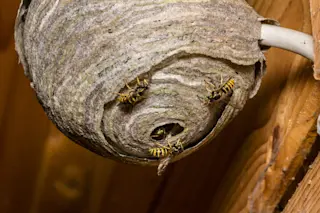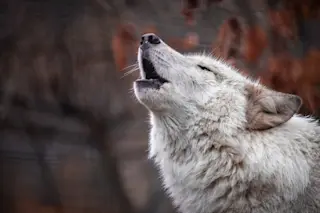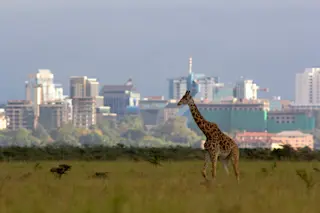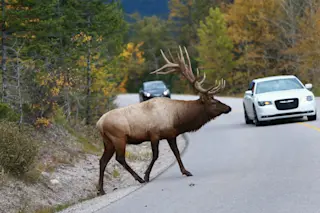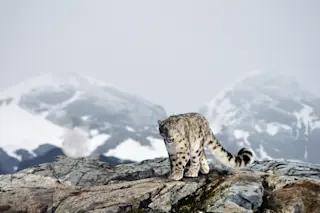Being the father of twin ten-year-old basketball fans has given me plenty of opportunities to observe the consequences of competition among humans, adults as well as children. When I watch a game with my sons, I can’t help but see that today’s nba players are incomparably better than they were during my childhood 50 years ago. Clearly, unrelenting competition at every level is what has driven those rising standards.
Having devoted much of my career as a biologist to studying competition among animals, I was well prepared for that observation—equally unrelenting competition has driven rising standards throughout the biological world. Modern dominant animals are improvements over those of hundreds of millions of years ago: they can occupy much colder climates, sustain much higher metabolic rates, and run faster.
The ways in which competition operates can be subtle. It’s not always as obvious as one elk goring another or John Stockton elbowing Michael Jordan. I recently had the good fortune to observe a fascinating biological contest in New Guinea. It involved parrots and fruit trees, two groups of species familiar to us but not thought of as fierce combatants. Yet the race between the parrots and the plants has led to both superior parrots and superior plants. I see their battle as a model for all other battles that have driven evolution during the several billion years of life on Earth.
The scene of magical beauty that greeted me in New Guinea hardly suggested a battlefield. My colleague David Bishop and I had set out to survey birds in the uninhabited and unexplored peaks of New Guinea’s Van Rees Mountains. Since there were no people, roads, or trails in the area, the only access was by helicopter. It’s impossible to land a helicopter in tall, dense rain forest, so we were delighted to spot, just a mile below the highest peak, a small area where a landslide had left the ground bare. Our helicopter pilot dropped us off with three New Guinean field assistants—Robert, Peter, and Bennie of the Ketengban tribe—and half a ton of supplies, then waved good-bye, promising to return three weeks later. Surrounded by gorgeous rain forest, birdsongs, clear streams, and clean air, we felt as if we were in heaven.
We were not the only creatures who considered this place heaven. That first morning, hundreds of parrots of five different species—white cockatoos, palm cockatoos, green and red eclectus parrots, Pesquet’s parrots, and rainbow lorikeets—flew in, perched in nearby trees, then slipped down from the canopy to disappear in the jungle. Later in the afternoon, dozens of large pigeons of three species flew in, eventually making their way out again over the next several hours. Every day this spectacle repeated itself: parrots in the morning, pigeons in the afternoon, and occasionally crows. All these birds, once they landed in the nearby trees, descended to the ground and—to our astonishment—ate the bare dirt exposed by the landslide. This was evidently a prized location and a rare opportunity for the birds, as we could see them approaching from a distance of at least a mile away. Since most of New Guinea is covered with jungle, and herbs and fallen leaves blanket the ground, the rare landslide or cut riverbed affords birds their only exposure to large areas of soil.
But why did the birds want to eat soil in the first place? What good does it do them? If it’s somehow advantageous, why don’t more species seek the same benefits? Of the 140 bird species that we recorded near our camp, we observed only eight eating soil, all of them plant eaters (consumers of fruit, seeds, and flowers). Why isn’t soil also good for New Guinea’s carnivores, or for the region’s dozens of other species of plant-eating birds, such as berry peckers, flower peckers, and honeyeaters?
Actually, eating soil is widespread among animals of many families on all continents. It’s also widespread among people, especially traditional tribal societies. Scientists term the practice geophagy (from the Greek roots geo for earth and phagein for eat). The more I learned about geophagy, the more I realized that it is often used as a potent weapon in an escalating war waged by plants and animals.
In North America, geophagy is associated with the more familiar term lick, meaning a place where animals gather to eat soil. Our wild animals don’t eat just any dirt; they instead come many miles to certain sites commemorated in innumerable American place names: Licking Hollow, Elk Lick, Three Lick Bed, and so on.
Virtually all species of wild North American hoofed animals, such as bison and moose, visit licks, as do bears and some small animals, such as rabbits, squirrels, and woodchucks. Just as in New Guinea, North American licks also attract parrots and pigeons. Once these included the now-extinct Carolina parakeet, and today licks are frequented by the still-extant mourning dove and band-tailed pigeon. Animals have been visiting our licks for tens of thousands of years, as attested by bones of mammoths, mastodons, ground sloths, and other big extinct mammals.
Wild animals on all other continents also engage in geophagy. Predominantly, the soil-eating species are herbivores: antelopes, apes, giraffes, and zebras in Africa; monkeys, peccaries, and tapir in South America; deer in Europe and Asia; parrots in South America; and butterflies in many places.
Licks are even more familiar to our domestic livestock. Ranchers find that feeding selected soils to cows, sheep, goats, and pigs results in improved health, weight gain, and food intake, plus enhanced food conversion into meat, by 20 percent or more.
Since most humans consume more plant food than meat, it should come as no surprise that geophagy is also widespread in peasant communities on all continents, with descriptions going back to Roman times. In such communities, pregnant and lactating women especially crave soil, typically consuming one-and-a-half ounces or more per day. Like other animals, humans are very selective about the soils we eat. For example, each year 500 tons of prized clay are extracted from the ground or from termite mounds near the village of Uzalla, Nigeria, for export and sale in markets up to 1,000 miles away throughout West Africa. In Zambia and Zimbabwe the main sources of soil, which 90 percent of rural women consume while pregnant, are giant termite mounds that also attract cows and giraffes.
Why should anyone—person, ungulate, or bird—eat soil? And how do dirt eaters choose which soil to consume? Why do plant-eating animals and pregnant or nursing women particularly hunger for soil? You might suppose the easiest way to get answers would be to ask people, since animals can’t tell us. But if you quiz soil-eating people about their motives, they just give unhelpful replies like I feel good when I eat it or I like the taste. If you press them, they say they think it cures stomach problems or worms or diarrhea or aids, or that it is good for them during pregnancy, or that it adds a good taste to food or masks bitter tastes, or that it is useful as a pacifier in a baby’s mouth. These varied answers don’t identify precise physiological explanations for geophagy, but they suggest several possible benefits. The six explanations most discussed among zoologists, anthropologists, and doctors are to assuage hunger, to provide grit for grinding food in the stomach, to buffer stomach contents, to cure diarrhea, to serve as a mineral supplement, and to adsorb toxins.
While tracking down answers for my New Guinea parrots and other birds, I was fortunate to receive a letter from James Gilardi, then a graduate student at the University of California at Davis doing his Ph.D. research on geophagy in Amazonian parrots. Gilardi had gathered far more extensive data on geophagy by his parrots than Bishop and I could gather in our three weeks in New Guinea, and he was kind enough to carry out chemical analyses on some of our New Guinea soil samples along with his own Amazonian soils. Gilardi’s detailed studies and Bishop’s and my brief observations allowed us to assess how well those six theories of geophagy apply to parrots. Some people say that they eat soil to fill their stomachs when little food is available. For example, the Ottomac Indians of South America made soil balls six inches in diameter and ate more than one pound per day during the flood season, when it was difficult to find food. Geophagy has also been reported in Western Europe during famines. But it is implausible that this theory of assuaging hunger applies to Gilardi’s and our parrots, which were busily feeding in fruit trees most of the time and eating soil just for a late-morning brunch or teatime snack.
A second theory notes that birds lack teeth. Many bird species with weak bills swallow coarse dirt or pebbles with which to grind swallowed food in their tough, muscular gizzards. But when Gilardi measured the particle sizes of soils consumed by parrots, he found that his birds and ours were choosing extremely fine clays useless for grinding. In fact, his parrots selected soil from a soil bed, exposed in a river bank, that runs for hundreds of yards along the river, while largely ignoring soil one yard above and below. The soil bed preferred by his parrots was even finer than the soil immediately above and below it. Hence his and our parrots were clearly not interested in grit. On reflection, that conclusion is not surprising. Parrots have no need for grit to grind food, because they can cut and crush food with their strong, sharp bills.
A third theory concerns the need for buffering acidic or alkaline foods. When some hoofed livestock eat a plant diet low in fiber, for example, their rumens become so acidic that they kill bacteria essential for digestion. To buffer or neutralize plant acid, livestock select highly alkaline soils. But parrots don’t have a rumen, nor do they rely on bacteria for digestion. When Gilardi measured the buffering capacity of extracts of his and our soils, he found it to be zero.
A fourth suggested benefit of geophagy is to prevent diarrhea. Cholera, salmonella, and many other bacteria and parasites release toxins that cause diarrhea. The active ingredients of Kaopectate, an over-the-counter diarrhea medicine, are soil minerals that adsorb bacteria and their toxins. Researchers studying wild chimpanzees noticed that three animals eating soils rich in adsorbent minerals similar to kaolinite were suffering from severe diarrhea. But neither Gilardi nor Bishop and I detected any signs of diarrhea in our parrots.
In the scientific literature about geophagy, the most discussed hypothesis concerns its value as a mineral supplement, and there is compelling evidence that this explanation is valid in some cases. Traditional lick sites are often termed salt licks, on the assumption that animals are looking for nutritionally essential minerals or salts. That theory could help explain why geophagy is especially popular with pregnant and lactating women, who have an increased need for minerals (hence mineral supplements during pregnancy), and with deer that need minerals to grow antlers. Mineral requirements explain the otherwise bizarre bone-eating behavior of some animals. For example, pronghorn antelopes used to dig up shallow Indian graves to eat small, mineral-rich bones. Also, on some British islands sheep living alongside colonies of breeding seabirds so crave bone minerals that they don’t even wait for the birds to die but kill the birds themselves. Scientists who offer animals soils drenched with solutions of various alternative salts find that animals can recognize and choose the particular ones that their bodies need.
Which minerals are animals looking for? The list of suggestions for which there is some support comprises a significant fraction of the periodic table. Antler-growing deer eat soil rich in calcium and magnesium, and moose, butterflies, and other animals seek out soils for their sodium content. The clays pregnant Ghanaian women buy and consume every day in one-ounce doses contain up to two-thirds of the Food and Drug Administration’s recommended daily allowance of iron and one-third the fda’s normal daily intake of copper—often more than the mineral supplements that pharmaceutical companies produce for pregnant women. African termite mounds, which concentrate minerals up to five hundred–fold over adjacent soils, supply most or all the recommended daily allowances of six minerals for pregnant women.
But when Gilardi extracted his and our soils under conditions simulating those in an animal’s stomach, he found that the soils contained even less of most minerals than the fruits the parrots ate. Sodium levels in our soils were lower than those in tap water and probably in jungle water as well. Concentrations of most minerals were no higher in the thin soil band that Gilardi’s parrots selected than in the rejected bands above and below. Could his and our parrots nevertheless have been seeking minerals, and were they making a big mistake in the soils they were choosing? That would be a departure from their sophisticated feeding ecology. Much more likely, the parrots did know what they were doing, and they were not after minerals at all.
The remaining theory is that geophagy serves to detoxify plants. Wild fruits and nuts are usually bitter, astringent, sour, or even poisonous. The nuts and fruits you find in the grocery store are either among the few species that weren’t bitter in the wild (such as sunflower seeds) or underwent selection during domestication to eliminate their bad taste (such as almonds). Why should so many wild seeds and fruits evolve to become bad-tasting or poisonous?
Understanding the answer requires us to adopt a plant’s point of view. Most animals can walk, swim, or fly, so their offspring disperse under their own power to seek new habitats. But seeds can’t propel themselves to a new habitat. Instead many mother plants enlist the help of animals, by enclosing the seed in the tasty pulp of a fruit. An animal is thereby persuaded to swallow the fruit and digest the pulp, leaving the seed to be either spat out, dropped, or swallowed and eventually expelled in the animal’s feces, somewhere away from the seed’s mother tree.
A mother plant wants its seeds to be dispersed when they’re mature and capable of germination; the plant seeks to prevent animals from eating the fruit when it’s unripe and the seeds are not ready to sprout, or from eating the seeds themselves. Plants have evolved to achieve their aims by making the unripe fruit bad-tasting (try eating an unripe persimmon) and by lacing the seeds or their coatings with bad-tasting or downright poisonous chemicals.
But animals have their own point of view, and that’s where the warfare escalates. Plants endow seeds with a concentrated supply of carbohydrate, protein, and lipid to give the seedling a good start in life. Naturally, animals could profit by commandeering that supply for themselves, so they have evolved various ways to detoxify or get rid of the poisons or bad taste. An animal that can eat a fruit before it is fully ripe thereby defeats another animal that might otherwise have eaten the fruit, and simultaneously defeats the plant (because an immature seed won’t germinate). Plants whose seeds succumb to animals fail to propagate their genes, unlike plants that escalate the war and make a better poison. Animals that defeat even the improved poisons get well nourished and leave behind offspring carrying their genes.
The penalty for losing a battle in this evolutionary race is severe. Some trees lose to animal consumers every seed they produce. Conversely, every winter near my home in Los Angeles, one can pick up small birds called cedar waxwings lying helplessly on the ground, intoxicated by fruits they were eating.
Parrots are champions in these races. Some obvious reasons for their success are their strong bills, muscular tongues, and oral dexterity: just watch a pet parrot peel the thin aluminum foil off a candy bar. But other reasons for their success are not immediately obvious. Somehow, parrots have made themselves relatively immune to plant poisons and bad tastes. They specialize in eating seeds and unripe fruits, despite high concentrations of alkaloids and other toxins that would be awful-tasting or fatal to humans. For instance, in a standard laboratory test of toxicity, low doses of chemicals extracted from seeds that parrots happily eat kill brine shrimp. To achieve a measurable blood level of the alkaloid quinidine, parrots require a dose higher by fiftyfold (relative to body weight) than do humans. The seeds wild parrots eat are mostly inedible by primates (including humans) and by other birds. How do parrots withstand the toxins in plants?
One secret is that parrots eat soils containing minerals particularly good at binding plant toxins, especially positively charged alkaloids (such as strychnine and quinine) and tannic acids, which give acorns and many other plant parts their bitter taste. The active minerals include kaolinite and smectite, the same ones distinguished for binding bacterial and parasitic toxins. Both our New Guinea clay and Gilardi’s Amazonian clay turned out to bind quinine and tannic acid even better than pure kaolinite. In fact, the Amazonian soil selected by parrots binds one-tenth of its own weight of quinine. It has 50 percent more binding capacity than the rejected soil bands immediately above and below it, which is presumably why the parrots selected that particular band. In laboratory tests with brine shrimp, mixing toxins with Amazonian soil extract removed half the toxic effect of quinidine and two-thirds the toxic effect of poisonous seeds. When parrots were given an oral dose of their preferred soil at the same time as an oral dose of quinidine, the soil reduced the birds’ resulting blood level of quinidine by 60 percent, by binding the alkaloid in the birds’ intestines.
Humans also use geophagy to protect themselves against plant toxins. Some South American Indians regularly dine on bitter, toxic wild potatoes containing a nasty alkaloid that by itself would cause stomach pains and vomiting. However, the Indians have learned to make the potatoes safe and palatable by eating them with an alkaloid-binding clay. California Indians and natives of Sardinia used to make a bread from nutritious acorns whose sole drawback was that they contained bitter, astringent, and toxic tannic acid. Both the Indians and the Sardinians mixed the acorn flour with a clay that reduced tannic acid by up to 77 percent. These peoples did not understand alkaloid chemistry or adsorption, but they did discover empirically that geophagy made these foods edible and pleasant.
Honed by constant warfare against plants protecting their seeds, and against competing animals trying to get to the seeds first, parrots have evolved into one of the most successful groups of birds. They occupy every continent except Europe and Antarctica, and number approximately 350 species. They range in size from New Guinea’s tiny pygmy parrots, barely three inches long and weighing a third of an ounce, to New Zealand’s giant flightless nocturnal kakapo, two feet long and weighing up to four pounds. Despite this diversity, most parrots share a preference for fruits and seeds as food, as well as adaptations that make them champion plant eaters. They are highly intelligent (one African gray parrot has learned to speak and evidently understand more than 100 English words). Their strong bills enable them to crack hard seeds. Their strong tongues and oral dexterity allow them to separate edible plant parts from poisonous, bad-tasting, or indigestible parts. They can detoxify plant poisons, by geophagy and probably by other undiscovered means as well. And all parrots except the kakapo are strong fliers, allowing them to commute between widely scattered fruit trees and soil licks over dauntingly long distances.
In these ways parrots have kept one step ahead of many plants and plant-eating animals. The next time you walk in the woods, try biting some wild fruit or seed. As you pucker up at its awful taste, reflect to yourself: the race against the parrots did that. You have just been outclassed by the Dream Team of the biological world, the parrots and the fruit-bearing plants.




